Mapping Surface Quartz Content in Sand Dunes Covered by Biological Soil Crusts Using Airborne Hyperspectral Images in the Longwave Infrared Region
Abstract
:1. Introduction
2. Materials and Methods
2.1. The Study Area
2.2. Airborne Data
2.3. Atmospheric-Feature Reduction and Surface-Feature Enhancement
2.4. Laboratory and Ground Measurements
2.5. Quartz Classification
3. Results
3.1. Atmospheric Reduction
3.2. Validation of the Atmospheric Feature Reduction Procedure
3.3. Quartz Content
4. Discussion
5. Conclusions
Author Contributions
Funding
Acknowledgments
Conflicts of Interest
References
- Ben-Dor, E.; Chabrillat, S.; Demattê, J.A.M.; Taylor, G.R.; Hill, J.; Whiting, M.L.; Sommer, S. Using imaging spectroscopy to study soil properties. Remote Sens. Environ. 2009, 113, S38–S55. [Google Scholar] [CrossRef]
- Eisele, A.; Chabrillat, S.; Hecker, C.; Hewson, R.; Lau, I.C.; Rogass, C.; Segl, K.; Cudahy, T.J.; Udelhoven, T.; Hostert, P.; et al. Advantages using the thermal infrared (TIR) to detect and quantify semi-arid soil properties. Remote Sens. Environ. 2015, 163, 296–311. [Google Scholar] [CrossRef]
- Vaughan, R.G.; Calvin, W.M.; Taranik, J.V. SEBASS hyperspectral thermal infrared data: surface emissivity measurement and mineral mapping. Remote Sens. Environ. 2003, 85, 48–63. [Google Scholar] [CrossRef]
- Notesco, G.; Ogen, Y.; Ben-Dor, E. Mineral classification of Makhtesh Ramon in Israel using hyperspectral longwave infrared (LWIR) remote-sensing data. Remote Sens. 2015, 7, 12282–12296. [Google Scholar] [CrossRef]
- Gillespie, A.; Rokugawa, S.; Matsunaga, T.; Steven Cothern, J.; Hook, S.; Kahle, A.B. A temperature and emissivity separation algorithm for advanced spaceborne thermal emission and reflection radiometer (ASTER) images. IEEE Trans. Geosci. Remote Sens. 1998, 36, 1113–1126. [Google Scholar] [CrossRef]
- Coll, C.; Caselles, V.; Rubio, E.; Sospedra, F.; Valor, E. Temperature and emissivity separation from calibrated data of the digital airborne imaging spectrometer. Remote Sens. Environ. 2001, 76, 250–259. [Google Scholar] [CrossRef]
- Young, S.J.; Johnson, B.R.; Hackwell, J.A. An in-scene method for atmospheric compensation of thermal hyperspectral data. J. Geophys. Res. Atmos. 2002, 107, 1–20. [Google Scholar] [CrossRef]
- Cheng, J.; Liang, S.; Wang, J.; Li, X. A stepwise refining algorithm of temperature and emissivity separation for hyperspectral thermal infrared data. IEEE Trans. Geosci. Remote Sens. 2010, 48, 1588–1597. [Google Scholar] [CrossRef]
- Borel, C.C.; Tuttle, R.F. Recent advances in temperature-emissivity separation algorithms. In Proceedings of the 2011 Aerospace Conference, Big Sky, MT, USA, 5–12 March 2011; pp. 1–14. [Google Scholar]
- Lahaie, P. Performance estimation tools for: Decoupling by filtering of temperature and emissivity (Defilte), an algorithm for thermal hyperspectral image processing. Int. J. High Speed Electron. Syst. 2008, 18, 675–699. [Google Scholar] [CrossRef]
- Weksler, S.; Notesco, G.; Ben-Dor, E. An automated procedure for reducing atmospheric features and emphasizing surface emissivity in hyperspectral longwave infrared (LWIR) images. Int. J. Remote Sens. 2017, 38, 4481–4493. [Google Scholar] [CrossRef]
- Notesco, G.; Kopačková, V.; Rojík, P.; Schwartz, G.; Livne, I.; Dor, E. Mineral classification of land surface using multispectral LWIR and hyperspectral SWIR remote-sensing data. A case study over the Sokolov Lignite Open-Pit Mines, the Czech Republic. Remote Sens. 2014, 6, 7005–7025. [Google Scholar] [CrossRef]
- West, N.E. Structure and function of microphytic soil crusts in wildland ecosystems of arid to semi-arid regions. Adv. Ecol. Res. 1990, 20, 179–223. [Google Scholar]
- Bowker, M.A. Biological soil crust rehabilitation in theory and practice: An underexploited opportunity. Restor. Ecol. 2007, 15, 13–23. [Google Scholar] [CrossRef]
- Burgheimer, J.; Wilske, B.; Maseyk, K.; Karnieli, A.; Zaady, E.; Yakir, D.; Kesselmeier, J. Relationships between normalized difference vegetation index (NDVI) and carbon fluxes of biologic soil crusts assessed by ground measurements. J. Arid Environ. 2006, 64, 651–669. [Google Scholar] [CrossRef]
- Belnap, J. The potential roles of biological soil crusts in dryland hydrologic cycles. Hydrol. Process. 2006, 20, 3159–3178. [Google Scholar] [CrossRef]
- Wu, N.; Zhang, Y.M.; Downing, A. Comparative study of nitrogenase activity in different types of biological soil crusts in the Gurbantunggut Desert, Northwestern China. J. Arid Environ. 2009, 73, 828–833. [Google Scholar] [CrossRef]
- Belnap, J.; Prasse, R.; Harper, K.T. Influence of Biological Soil Crusts on Soil Environments and Vascular Plants. In Ecological Studies; Springer: Berlin/Heidelberg, Germany, 2001; pp. 281–300. [Google Scholar]
- Belnap, J.; Weber, B.; Büdel, B. Biological Soil Crusts as an Organizing Principle in Drylands. In Ecological Studies; Springer International Publishing: Basel, Switzerland, 2016; pp. 3–13. [Google Scholar]
- Rozenstein, O.; Karnieli, A. Identification and characterization of biological soil crusts in a sand dune desert environment across Israel-Egypt border using LWIR emittance spectroscopy. J. Arid Environ. 2015, 112, 75–86. [Google Scholar] [CrossRef]
- Rozenstein, O.; Zaady, E.; Katra, I.; Karnieli, A.; Adamowski, J.; Yizhaq, H. The effect of sand grain size on the development of cyanobacterial biocrusts. Aeolian Res. 2014, 15, 217–226. [Google Scholar] [CrossRef]
- Rozenstein, O.; Adamowski, J. A review of progress in identifying and characterizing biocrusts using proximal and remote sensing. Int. J. Appl. Earth Obs. Geoinform. 2017, 57, 245–255. [Google Scholar] [CrossRef]
- Rozenstein, O.; Agam, N.; Serio, C.; Masiello, G.; Venafra, S.; Achal, S.; Puckrin, E.; Karnieli, A. Diurnal emissivity dynamics in bare versus biocrusted sand dunes. Sci. Total Environ. 2015, 506–507, 422–429. [Google Scholar] [CrossRef] [PubMed]
- Qin, Z.; Berlinerw, P.; Karnieli, A. Micrometeorological modeling to understand the thermal anomaly in the sand dunes across the Israel-Egypt border. J. Arid Environ. 2002, 51, 281–318. [Google Scholar] [CrossRef]
- Roskin, J.; Blumberg, D.G.; Porat, N.; Tsoar, H.; Rozenstein, O. Do dune sands redden with age? The case of the northwestern Negev dunefield, Israel. Aeolian Res. 2012, 5, 63–75. [Google Scholar] [CrossRef]
- Roskin, J.; Porat, N.; Tsoar, H.; Blumberg, D.G.; Zander, A.M. Age, origin and climatic controls on vegetated linear dunes in the northwestern Negev Desert (Israel). Quat. Sci. Rev. 2011, 30, 1649–1674. [Google Scholar] [CrossRef]
- Karnieli, A.; Tsoar, H. Spectral reflectance of biogenic crust developed on desert dune sand along the Israel-Egypt border. Int. J. Remote Sens. 1995, 16, 369–374. [Google Scholar] [CrossRef]
- Tsoar, H.; Blumberg, D.G.; Wenkart, R. Formation and Geomorphology of the North-Western Negev Sand Dunes; Springer: Berlin/Heidelberg, Germany, 2008; pp. 25–48. [Google Scholar]
- Tsoar, H.; Karnieli, A. What determines the spectral reflectance of the Negev-Sinai sand dunes. Int. J. Remote Sens. 1996, 17, 513–525. [Google Scholar] [CrossRef]
- Breckle, S.W.; Yair, A.; Veste, M. Arid Dune Ecosystems: The Nizzana Sands in the Negev Desert; Springer: Berlin/Heidelberg, Germany, 2008; ISBN 9783540754978. [Google Scholar]
- Zaady, E.; Katra, I.; Yizhaq, H.; Kinast, S.; Ashkenazy, Y. Inferring the impact of rainfall gradient on biocrusts’ developmental stage and thus on soil physical structures in sand dunes. Aeolian Res. 2014, 13, 81–89. [Google Scholar] [CrossRef]
- Kidron, G.J.; Barzilay, E.; Sachs, E. Microclimate control upon sand microbiotic crusts, western Negev Desert, Israel. Geomorphology 2000, 36, 1–18. [Google Scholar] [CrossRef]
- Karnieli, A.; Kidron, G.J.; Glaesser, C.; Ben-Dor, E. Spectral characteristics of cyanobacteria soil crust in semiarid environments. Remote Sens. Environ. 1999, 69, 67–75. [Google Scholar] [CrossRef]
- Qin, Z.; Berliner, P.R.; Karnieli, A. Ground temperature measurement and emissivity determination to understand the thermal anomaly and its significance on the development of an arid environmental ecosystem in the sand dunes across the Israel-Egypt border. J. Arid Environ. 2005, 60, 27–52. [Google Scholar] [CrossRef]
- Kruse, F.A.; Lefkoff, A.B.; Boardman, J.W.; Heidebrecht, K.B.; Shapiro, A.T.; Barloon, P.J.; Goetz, A.F.H. The spectral image processing system (SIPS)—Interactive visualization and analysis of imaging spectrometer data. Remote Sens. Environ. 1993, 44, 145–163. [Google Scholar] [CrossRef]
- Cudahy, T.; Caccetta, M.; Thomas, M.; Hewson, R.; Abrams, M.; Kato, M.; Kashimura, O.; Ninomiya, Y.; Yamaguchi, Y.; Collings, S.; et al. Satellite-derived mineral mapping and monitoring of weathering, deposition and erosion. Sci. Rep. 2016, 6, 23702. [Google Scholar] [CrossRef] [PubMed] [Green Version]
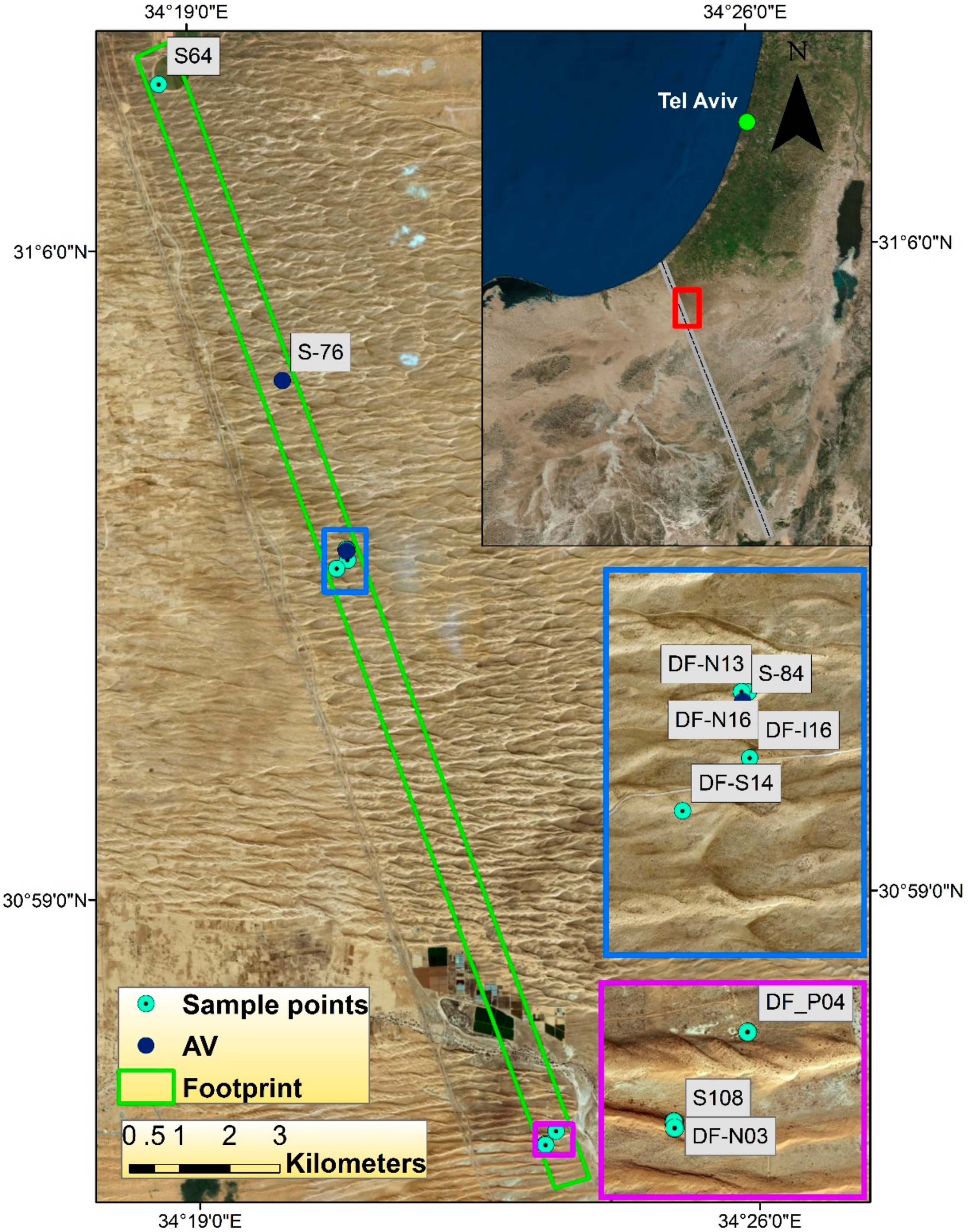

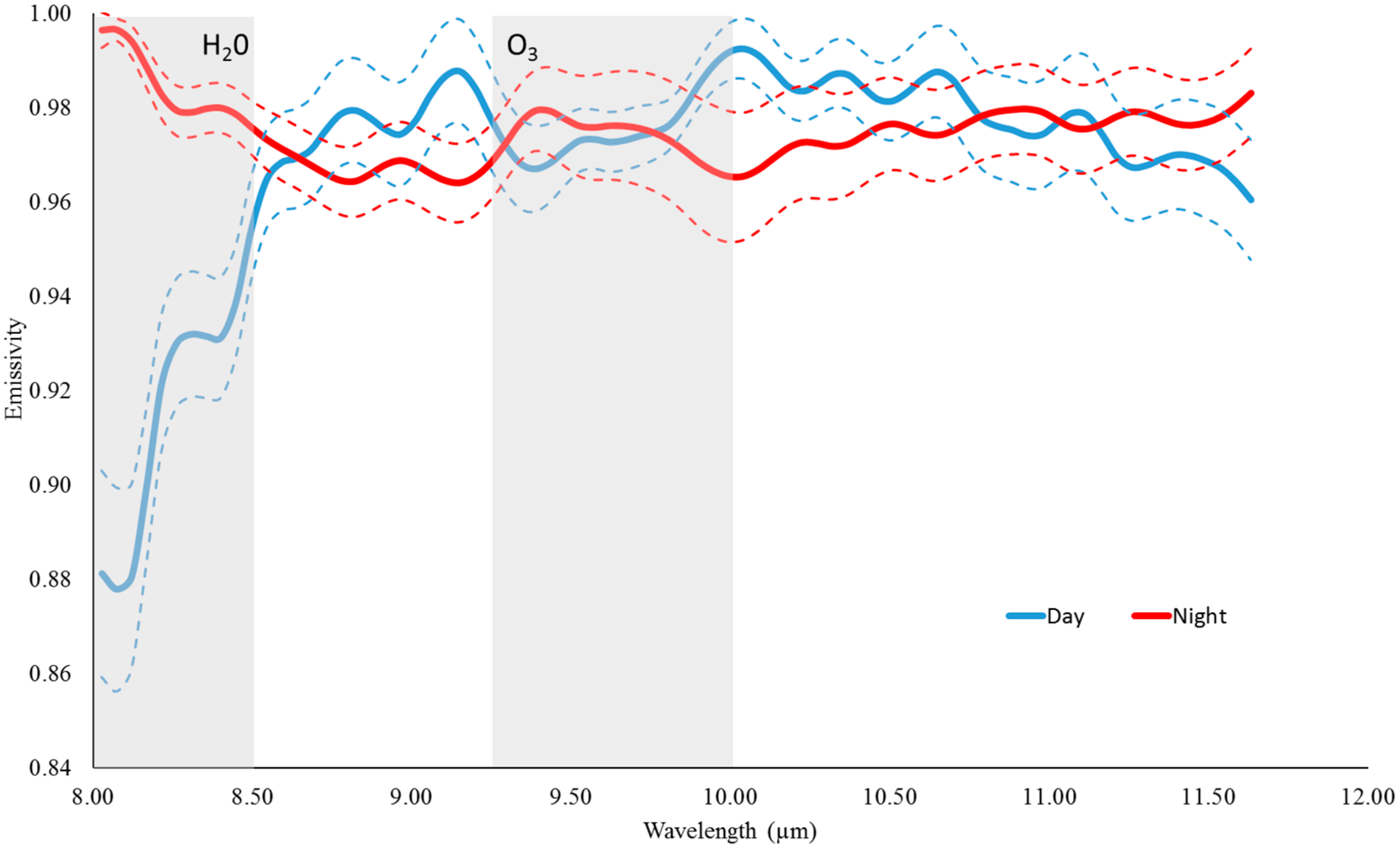
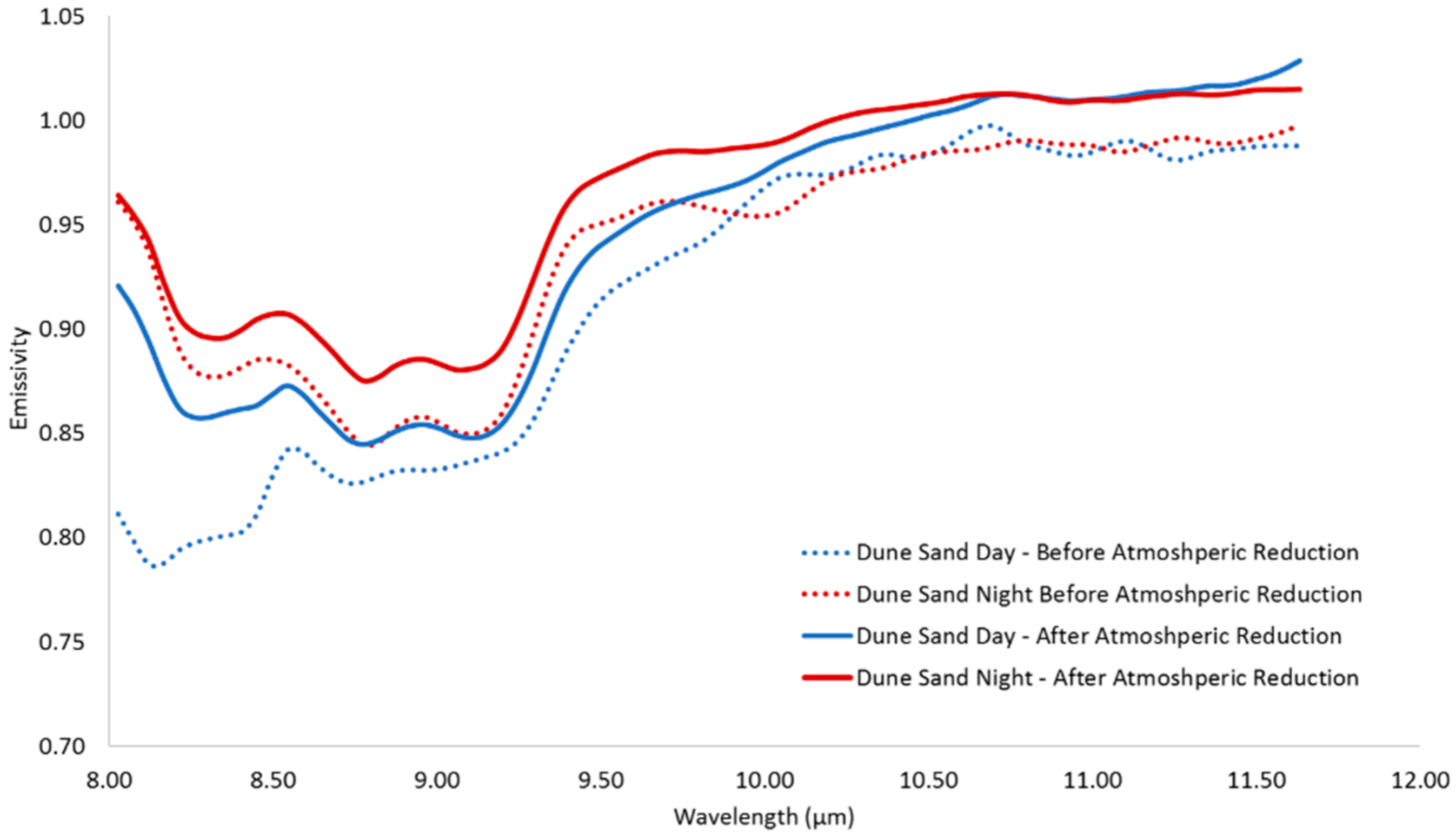
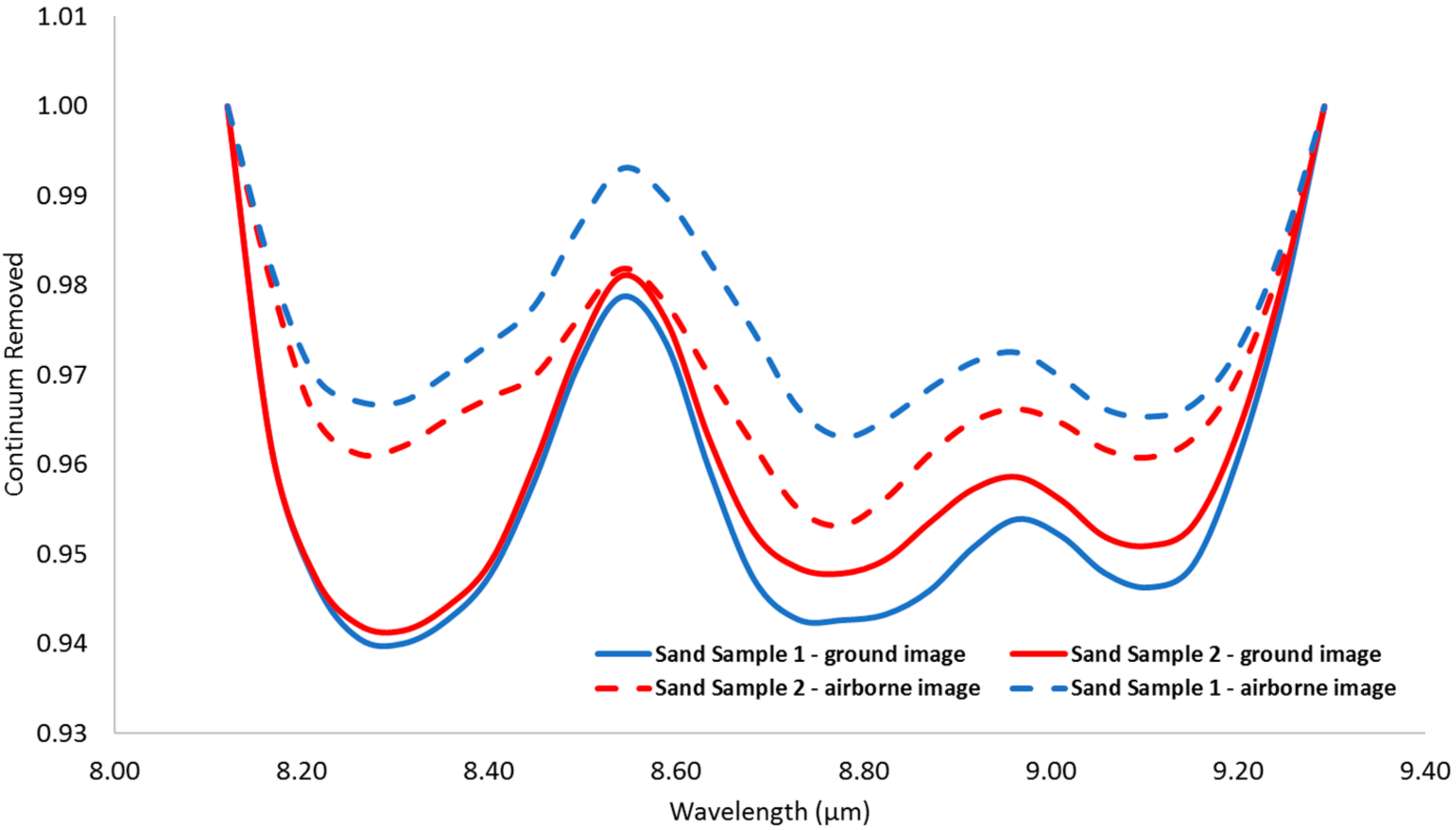
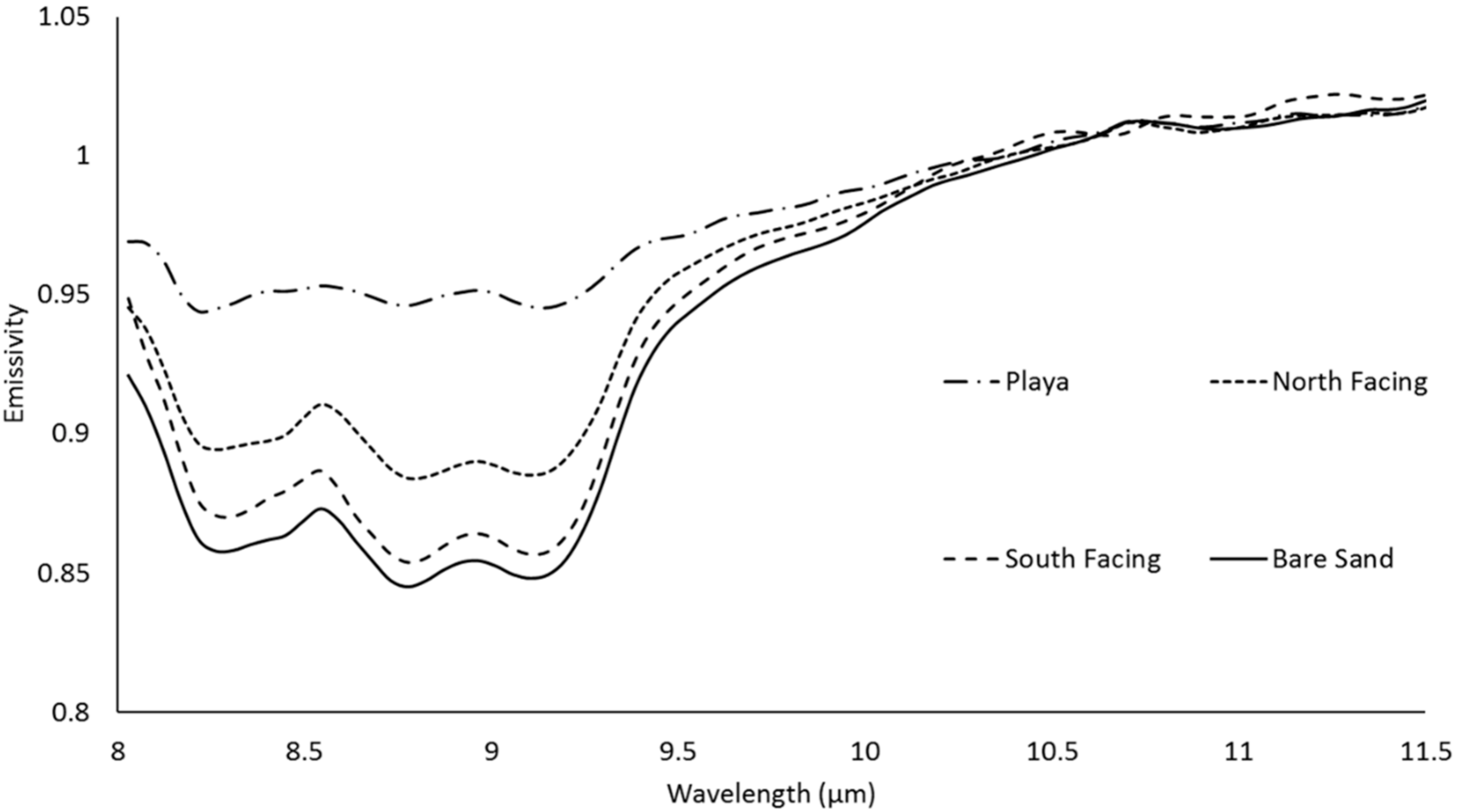
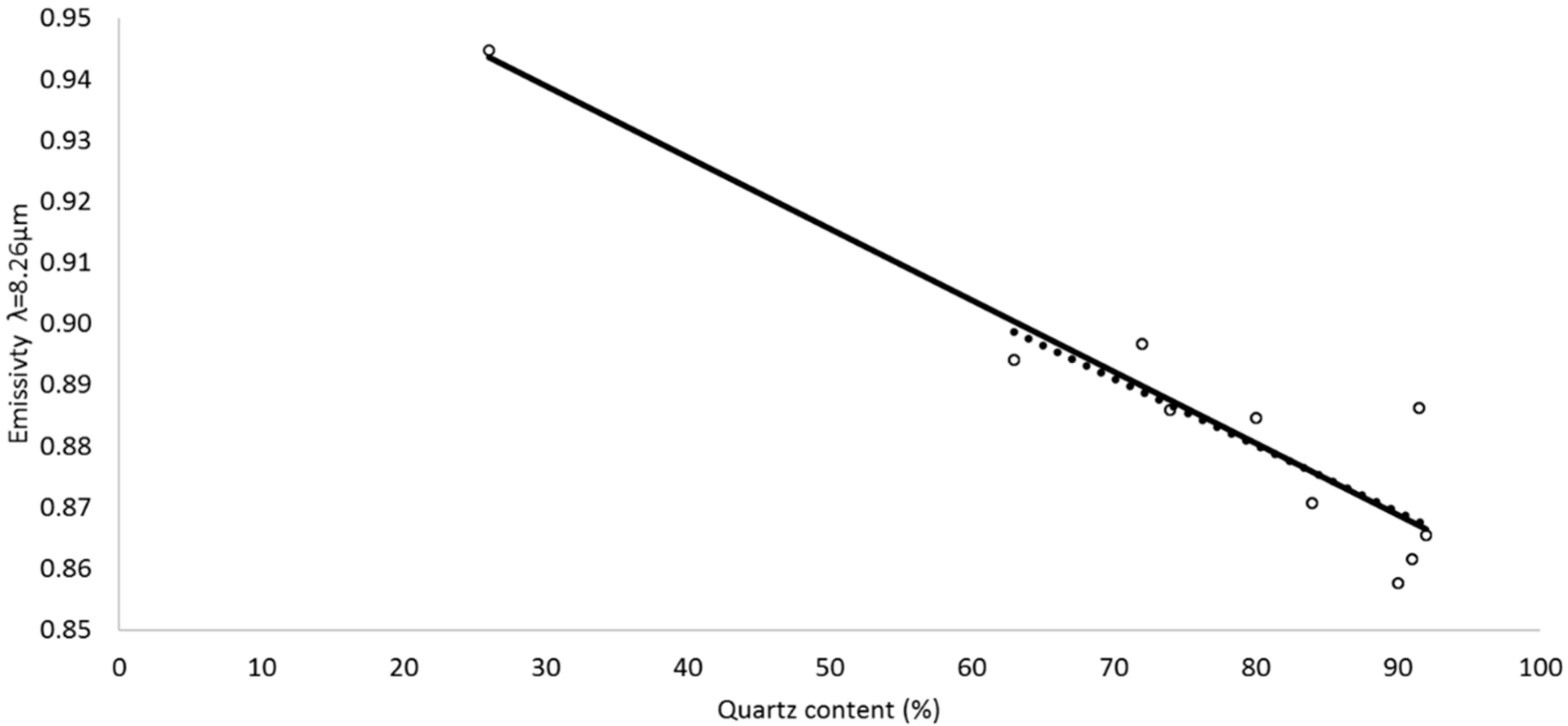
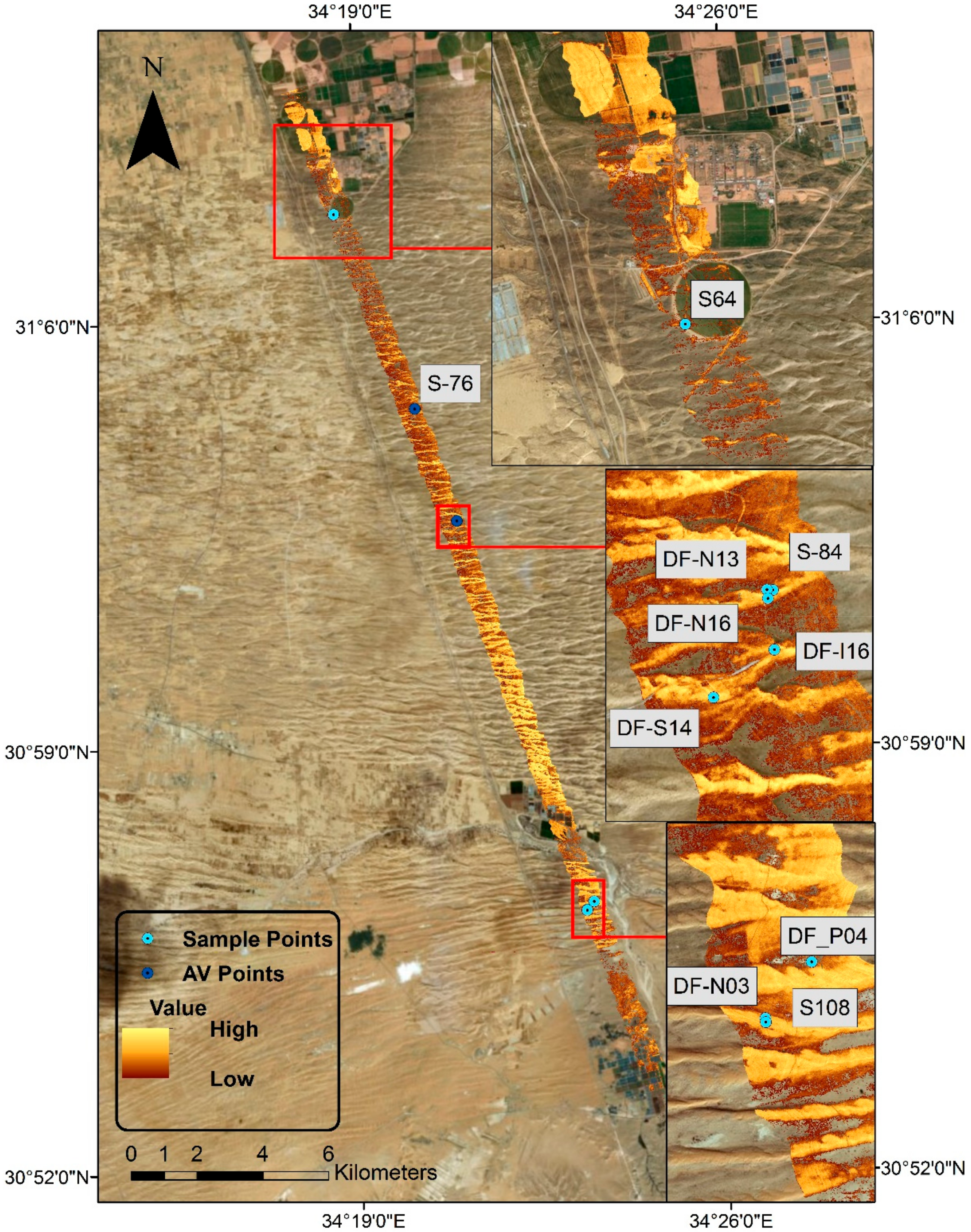
| Sample | Quartz | Carbonates (Calcite, Dolomite) | Silicates (Albite, Anorthite) | Clay (Illite, Kaolinite) |
|---|---|---|---|---|
| S84 | 90 | 0.5 | 9.5 | - |
| S108 | 91 | 3 | 6 | - |
| S76 | 92 | trace | 8 | - |
| S64 | 91.5 | 0.5 | 8 | - |
| DF-N03 | 80 | 8 | 12 | trace |
| DF-N16 | 63 | 19.5 | 10.5 | 7 |
| DF-N13 | 72 | 15 | 11 | 2 |
| DF-S14 | 84 | 2 | 14 | - |
| DF-I16 | 74 | 9 | 15 | 2 |
| DF-P04 | 26 | 51 | 10 | 13 |
| DNSO | 1.0 | 0.88 | 0.87 | 0.86 | 0.84 | 0.83 | 0.82 | 0.81 | 0.79 |
|---|---|---|---|---|---|---|---|---|---|
| No. of pixels | 0 | 2 | 4 | 22 | 77 | 199 | 436 | 926 | 2058 |
| Sand Sample 1 before DNSO | Sand Sample 1 after DNSO | Sand Sample 2 before DNSO | Sand Sample 2 after DNSO | |
|---|---|---|---|---|
| Angle | 0.049 | 0.031 | 0.039 | 0.020 |
© 2018 by the authors. Licensee MDPI, Basel, Switzerland. This article is an open access article distributed under the terms and conditions of the Creative Commons Attribution (CC BY) license (http://creativecommons.org/licenses/by/4.0/).
Share and Cite
Weksler, S.; Rozenstein, O.; Ben-Dor, E. Mapping Surface Quartz Content in Sand Dunes Covered by Biological Soil Crusts Using Airborne Hyperspectral Images in the Longwave Infrared Region. Minerals 2018, 8, 318. https://doi.org/10.3390/min8080318
Weksler S, Rozenstein O, Ben-Dor E. Mapping Surface Quartz Content in Sand Dunes Covered by Biological Soil Crusts Using Airborne Hyperspectral Images in the Longwave Infrared Region. Minerals. 2018; 8(8):318. https://doi.org/10.3390/min8080318
Chicago/Turabian StyleWeksler, Shahar, Offer Rozenstein, and Eyal Ben-Dor. 2018. "Mapping Surface Quartz Content in Sand Dunes Covered by Biological Soil Crusts Using Airborne Hyperspectral Images in the Longwave Infrared Region" Minerals 8, no. 8: 318. https://doi.org/10.3390/min8080318






